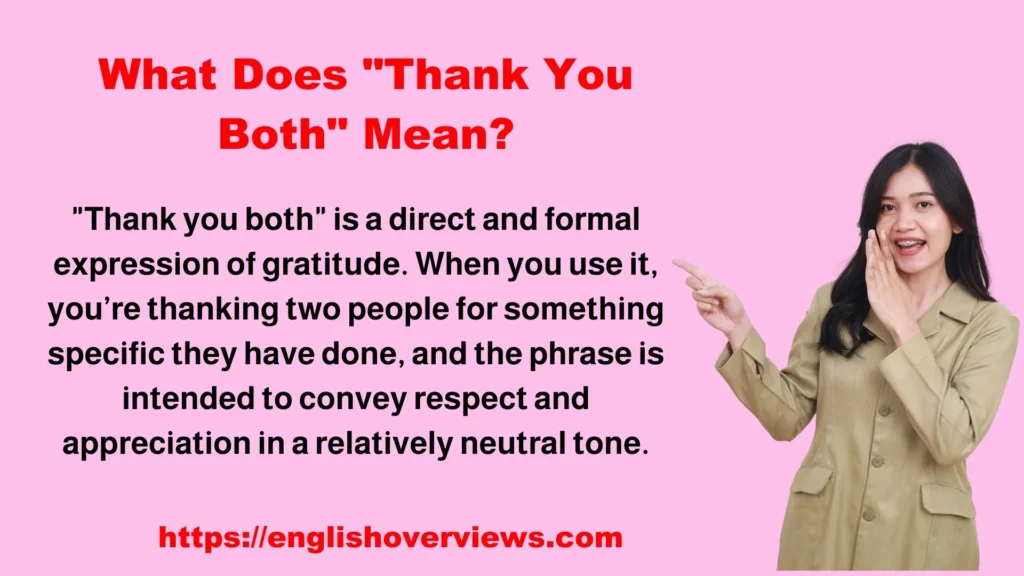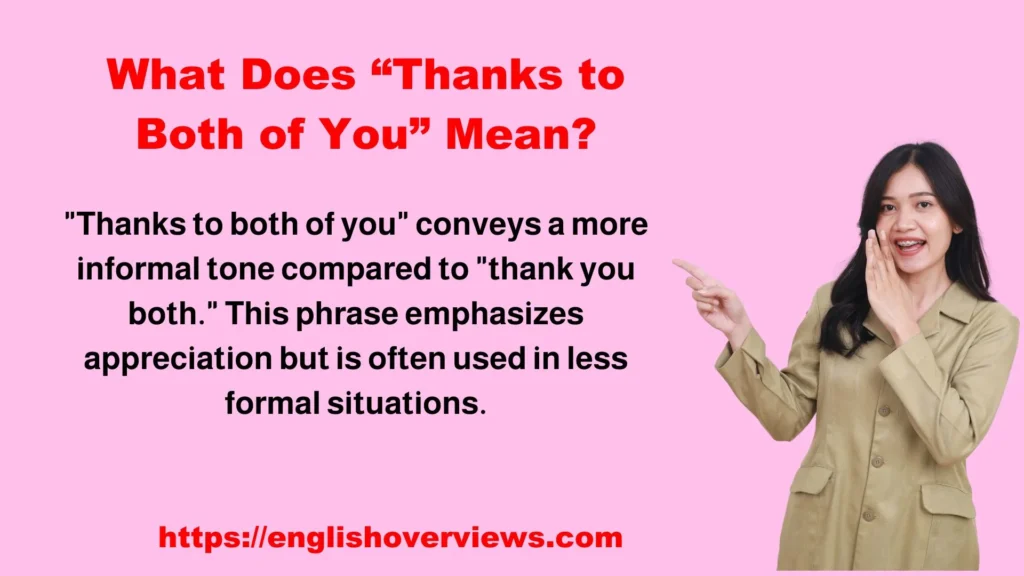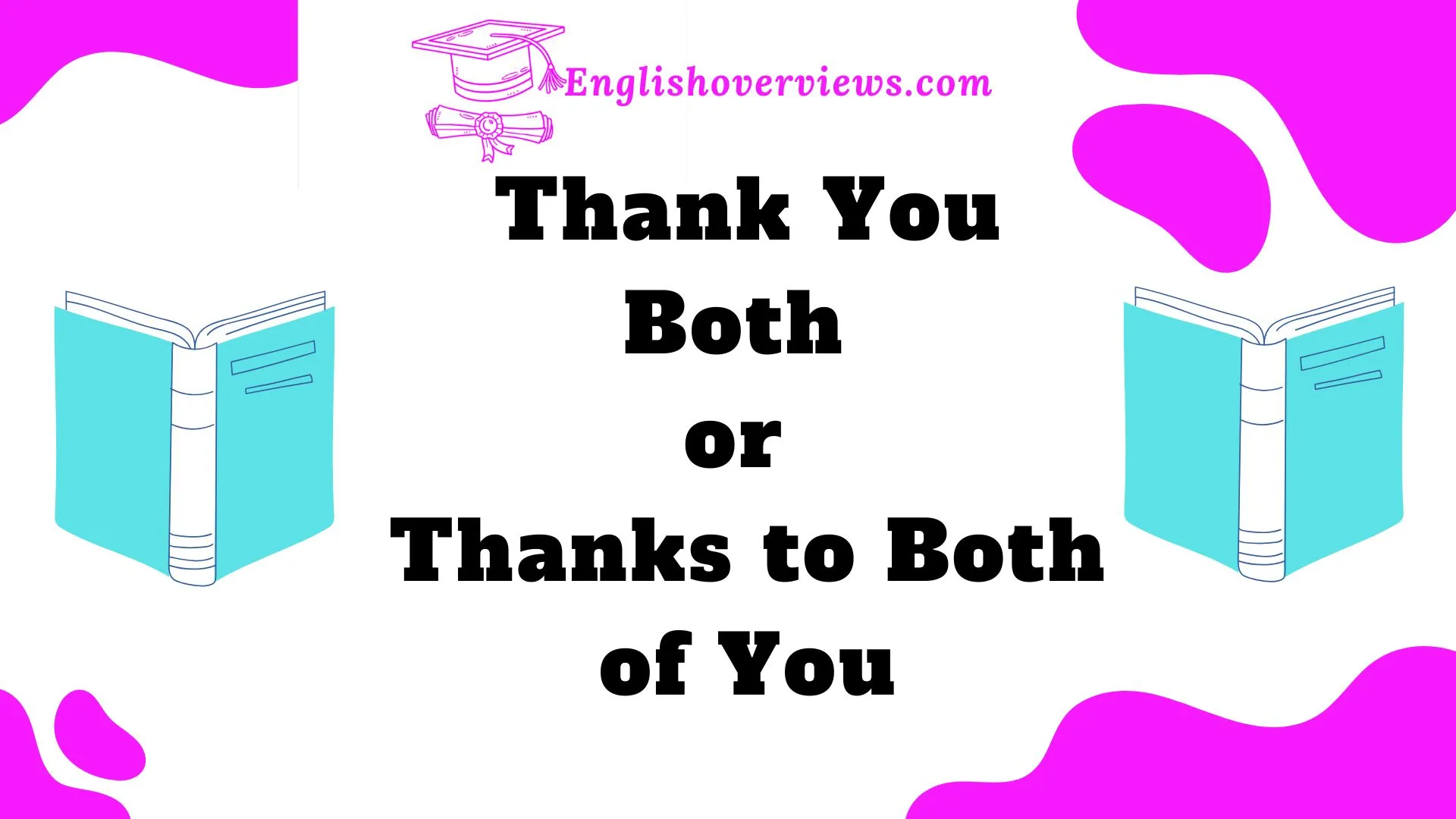When you want to express your gratitude, the way you phrase your thanks matters. In English, you have several options, but the choice between “Thank you both” and “Thanks to both of you” is often a point of confusion.
Both expressions seem like simple ways to show appreciation, but they come with subtle differences in meaning, tone, and appropriate usage.
Understanding these two phrases and their contexts can help you convey the right emotion and avoid awkward or inappropriate expressions of gratitude.
Whether you are writing an email, sending a text message, or addressing a group in person, it’s important to choose the right phrase to match your level of formality and relationship with the recipients.
This guide explores the differences, examples, and contexts for both “Thank you both” and “Thanks to both of you” to help you make the best choice in every situation.
Understanding the Basics: “Thank You Both” vs. “Thanks to Both of You”
At first glance, both “Thank you both” and “Thanks to both of you” appear quite similar, both expressing gratitude towards two people. However, there are key distinctions between the two, primarily in formality and tone.
“Thank You Both”
“Thank you both” is a phrase that carries a certain level of formality. It is a polite, respectful way to express gratitude to two people. The phrase uses the verb “thank”, which is the most straightforward and neutral way to convey appreciation in English.
It works well in both formal and informal contexts, although it tends to lean more toward the formal side, especially when you want to show appreciation in a professional setting or in written communication like emails or speeches.
Use Cases for “Thank You Both”
- Professional Settings: In emails or messages to colleagues, bosses, or clients, you would likely use “thank you both” to maintain a level of professionalism. It keeps the tone neutral and respectful while still conveying your gratitude.
- Example: “Thank you both for your input during today’s meeting.”
- Public Speaking: If you’re thanking two people publicly, especially in a setting like a conference, event, or ceremony, “thank you both” is a way to address them formally while expressing sincere appreciation.
- Example: “I would like to thank you both for your generous donations to the charity.”
- Respectful but Personal Conversations: When thanking two people who are not particularly close friends or family, “thank you both” can be used to maintain politeness.
- Example: “Thank you both for coming to the event and supporting the cause.”
While it’s not overly formal, “thank you both” still strikes a more neutral tone than “thanks to both of you.”
“Thanks to Both of You”
On the other hand, “Thanks to both of you” feels slightly more casual and informal. The word “thanks” is less formal than “thank you,” and the phrase generally conveys a warmer, more personal tone. It’s an expression you might use when addressing people you’re more familiar with, such as friends, family, or close colleagues.
Use Cases for “Thanks to Both of You”
- Casual Settings: This phrase works well in informal conversations—whether in person or over text messages. It gives off a sense of friendliness and appreciation without the formality of “thank you both.”
- Example: “Thanks to both of you for helping me move last weekend!”
- Everyday Gratitude: When you want to express thanks to people you have a more relaxed relationship with, “thanks to both of you” can feel more genuine and natural.
- Example: “Thanks to both of you, I was able to finish the project on time.”
- Social Media or Group Chats: It’s common to use “thanks to both of you” when addressing friends or acquaintances in a more public or casual context, like group chats or social media posts.
- Example: “Thanks to both of you for making my birthday amazing!”
While the tone of “thanks to both of you” is often more personal, the phrase is not entirely inappropriate in semi-formal settings either. It’s just less suitable in highly formal situations.
What Does “Thank You Both” Mean?

“Thank you both” is a direct and formal expression of gratitude. When you use it, you’re thanking two people for something specific they have done, and the phrase is intended to convey respect and appreciation in a relatively neutral tone.
Breaking Down “Thank You”
The phrase “thank you” is one of the most widely recognized and used expressions of gratitude in the English language. It’s simple, polite, and can be used in almost any situation—whether formal or informal. Here’s a breakdown:
- Gratitude: “Thank you” expresses thankfulness for something received, done, or given.
- Neutrality: It is a neutral expression, neither too formal nor too informal, making it suitable for a wide variety of occasions.
- Universality: Whether you’re thanking someone for a small favor or a major contribution, “thank you” fits comfortably in all situations, from customer service to personal interactions.
When to Use “Thank You Both”
You would use “thank you both” when addressing two people directly in order to show appreciation for something they did together or for you. It’s an acknowledgment of their effort or contribution, and it suggests that you hold both individuals in equal regard.
- Example 1: If two colleagues helped you complete a project, you might say, “Thank you both for staying late to finish this task.”
- Example 2: If two friends organized a surprise party for you, you might say, “Thank you both for making my birthday unforgettable!”
Alternatives for “Thank You”:
While “thank you” is a go-to expression of gratitude, you can change it up to add depth or express more emotion:
- “I really appreciate it”
- “I’m so grateful”
- “Much appreciated!”
These alternatives are often used to add emphasis or personalize the gratitude. Still, “thank you both” is often the safest and most universally appropriate option, especially when addressing two people.
Examples of “Thank You Both” in Action
To better understand when to use “thank you both,” let’s explore a few examples from different contexts. In each case, “thank you both” is used to express appreciation for the efforts of two people.
| Context | Example Sentence |
| Formal Email | “I would like to thank you both for your detailed feedback.” |
| Informal Conversation | “Thank you both for helping me organize the party!” |
| Social Media Post | “A huge thank you to both of you for the wonderful gift!” |
| Public Speaking | “I want to thank you both for your unwavering support over the years.” |
These examples highlight the versatility of the phrase “thank you both.” It works in formal settings, casual conversations, and even public speeches, making it one of the most widely used expressions of gratitude.
What Does “Thanks to Both of You” Mean?

“Thanks to both of you” conveys a more informal tone compared to “thank you both.” This phrase emphasizes appreciation but is often used in less formal situations.
Breaking Down “Thanks”
“Thanks” is the shortened form of “thank you,” and it carries the same general meaning. However, thanks is more relaxed, informal, and conversational, which makes it suitable for a more casual exchange. Here’s a breakdown:
- Casual Gratitude: While “thank you” might sound a little stiff, “thanks” is more laid-back, making it ideal for everyday conversations with people you know well.
- Relational Tone: “Thanks” feels more like a conversation, rather than a formal expression of gratitude.
When to Use “Thanks to Both of You”
“Thanks to both of you” is commonly used in personal conversations and informal settings. It’s the perfect expression of gratitude when you want to come across as genuine without sounding overly formal. Here’s when to use it:
- Casual Conversations: Use it when texting or chatting with friends or close colleagues. It conveys a friendly tone without being too stiff.
- Family and Close Friends: If two close friends or family members helped you, “thanks to both of you” is a great way to express your gratitude in a more personal way.
- Group Settings: It’s also a good option for group chats or social media posts, where a relaxed tone is appropriate.
Subtle Differences in Expression: How to Choose the Right Phrase
The real difference between “thank you both” and “thanks to both of you” comes down to tone and context. Let’s break this down even further to see how to make the right choice.
Use “Thank You Both” When:
- You want to maintain a respectful and polite tone.
- The setting is semi-formal or formal.
- You are speaking or writing to someone you don’t know very well or want to show extra politeness.
Use “Thanks to Both of You” When:
- You want to sound casual, warm, and approachable.
- The conversation is informal, such as with friends or family.
- You want to convey familiarity or personal connection.
It’s important to match your expression to the formality of the situation. Using “thanks to both of you” in a formal meeting could make you sound unprofessional, while “thank you both” in a casual conversation could make you seem too distant or stiff. Understanding the right context for each phrase will help you communicate more effectively.
“Thanks to” as an Idiom in English
In addition to being a simple expression of gratitude, the phrase “thanks to” can also function as an idiom in English, implying a cause-and-effect relationship.
Using “Thanks to” in Idiomatic Expressions
- Example: “Thanks to both of you, the project was completed ahead of schedule.”
Here, “thanks to” is used not only to show gratitude but to indicate that the outcome (the project being completed ahead of schedule) was made possible because of the efforts of the two people being thanked. - Example: “Thanks to both of you, my trip was unforgettable!”
In this case, the idiomatic use of “thanks to” makes it clear that the people being thanked are directly responsible for creating a memorable experience.
This subtle nuance in meaning adds an extra layer to “thanks to both of you,” emphasizing the impact of their actions.
Writing Tips: How to Use “Thank You Both” and “Thanks to Both of You” Correctly
Knowing when and where to use “thank you both” vs. “thanks to both of you” is crucial for effective communication. Here are some tips for ensuring you’re using the right phrase in your writing or conversation.
- For Formal Writing: Stick with “thank you both” when composing emails, letters, or messages to people in professional or formal contexts.
- For Informal Conversations: Use “thanks to both of you” when texting friends, chatting in group chats, or speaking casually with colleagues.
- Consider Tone: Always consider how formal or informal the situation is before choosing between the two. If you’re unsure, err on the side of caution with “thank you both.”
Choosing the right expression for the right context will help you communicate effectively and show your appreciation in the best possible way.
Conclusion: Choosing the Best Phrase for Every Situation
In summary, whether you use “thank you both” or “thanks to both of you” largely depends on the formality of the situation and the relationship you have with the people you’re thanking.
Both phrases have their place in English conversation, but understanding the subtle differences between them can ensure you’re always expressing gratitude in the most appropriate and natural way.
FAQs
1. Which is correct: “Thank you both” or “Thanks to both of you”?
Both are correct, but they are used slightly differently. “Thank you both” is more direct and commonly used in speech, while “Thanks to both of you” is often used when acknowledging gratitude in a sentence (e.g., “Thanks to both of you, we finished on time.”).
2. Is “Thank you both” formal or informal?
It is neutral and appropriate for both formal and informal settings. However, for very formal situations, you might say, “I extend my gratitude to both of you.”
3. Can I say “Thank you to both of you”?
Technically, it’s not incorrect, but it sounds a bit awkward. A better way to phrase it would be “Thanks to both of you” or simply “Thank you both.”
4. What’s the difference between “Thank you both” and “Thank you both very much”?
Adding “very much” emphasizes the gratitude and makes it more polite or heartfelt. “Thank you both” is straightforward, while “Thank you both very much” is more expressive.
5. Which is more common: “Thank you both” or “Thanks to both of you”?
“Thank you both” is more commonly used in everyday conversations. “Thanks to both of you” is used more in written or formal acknowledgments.

Alyan Ashraf is the creative mind behind English Overviews, a platform dedicated to helping learners master the English language. Passionate about education and language development, Alyan specializes in simplifying complex English concepts, making learning accessible for students of all levels.











